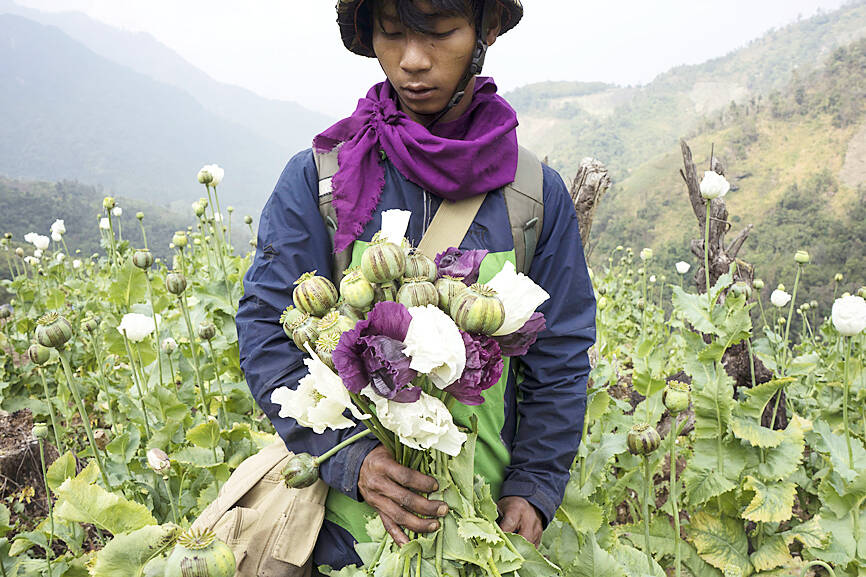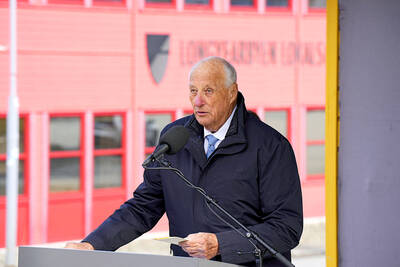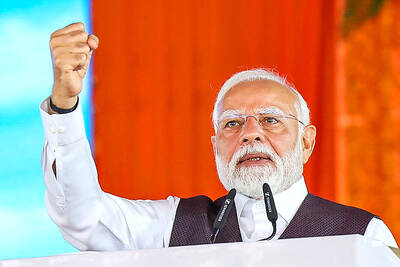The production of opium in Myanmar has flourished since the military’s seizure of power, with the cultivation of poppies up by one-third in the past year, as eradication efforts have dropped and the faltering economy has led more people toward the drug trade, a UN report released yesterday showed.
Last year, the first full growing season since the military wrested control of the country from the democratically elected government of Aung San Suu Kyi in 2021, saw a 33 percent increase in Myanmar’s cultivation area to 40,100 hectares, the UN Office on Drugs and Crime report said.
“Economic, security and governance disruptions that followed the military takeover of February 2021 have converged, and farmers in remote, often conflict-prone areas in northern Shan and border states have had little option but to move back to opium,” UN Office on Drugs and Crime Regional Representative Jeremy Douglas said.

Photo: AP
The overall value of the Myanmar opiate economy, based on UN estimates, ranges from US$660 million to US$2 billion, depending on how much is sold locally, and how much of the raw opium is processed into heroin or other drugs.
“Virtually all the heroin reported in East and Southeast Asia and Australia originates in Myanmar, and the country remains the second-largest opium and heroin producer in the world after Afghanistan,” Douglas said.
“There is no comparing the two at this point, as Afghanistan still produces far more, but the expansion underway in Myanmar should not be dismissed and needs attention as it will likely continue,” he said.
“It is directly tied to the security and economic situation we see unfolding today,” he added.
The so-called Golden Triangle area — where the borders of Myanmar, Laos and Thailand meet — has historically been a major production area for opium, and hosts many of the laboratories that convert it to heroin.
Decades of political instability have made the frontier regions of Myanmar largely lawless, to be exploited by drug producers and traffickers.
Most of the opium exported by Myanmar goes to China and Vietnam, while heroin goes to many countries across the region, Douglas said.
“It is really where the value is for traffickers,” he said. “Very high profits.”
The cultivation of opium had been trending downward before the military took control of the government in 2021.
Production estimates hit a bottom of 400 tonnes in 2020. After rising slightly in 2021, that spiked last year to an estimated 790 tonnes, the report said.
Since it took control of the government, the military’s use of deadly force to hold on to power has escalated conflict with its civilian opponents to the point that some experts describe the country as being in a state of civil war.
The costs have been high, with 2,810 people killed by government forces and 17,427 detained, the Assistance Association for Political Prisoners said.
The violence has meant that the government has been unable to reach some areas to carry out drug eradication raids, and has also had to divert its resources elsewhere.
Consequently, elimination efforts appear to have decreased substantially, with 1,403 hectares eradicated last year — about 70 percent less than in 2021.
At the same time, as the conflict continues to take its toll on Myanmar’s economy, an increasing number of rural households have been pushed into relying more on opium cultivation for income, the UN said.
“The expansion of opium production that is underway is fundamentally about poverty and people in rural areas reacting to the economic situation,” Douglas said.
“It has always been there in tough times. At the same time, the security situation is clearly difficult, with increasing frequency and intensity of conflict, and those involved in the drug economy have been left largely unchecked,” he said.
Myanmar’s synthetic drug economy has also been surging for the same reasons, with reported regional seizures of methamphetamine and other drugs reaching record levels.
In a single bust in September last year in Laos, for example, authorities seized 33 million methamphetamine tablets along with 500kg of crystal methamphetamine.

Former Nicaraguan president Violeta Chamorro, who brought peace to Nicaragua after years of war and was the first woman elected president in the Americas, died on Saturday at the age of 95, her family said. Chamorro, who ruled the poor Central American country from 1990 to 1997, “died in peace, surrounded by the affection and love of her children,” said a statement issued by her four children. As president, Chamorro ended a civil war that had raged for much of the 1980s as US-backed rebels known as the “Contras” fought the leftist Sandinista government. That conflict made Nicaragua one of

COMPETITION: The US and Russia make up about 90 percent of the world stockpile and are adding new versions, while China’s nuclear force is steadily rising, SIPRI said Most of the world’s nuclear-armed states continued to modernize their arsenals last year, setting the stage for a new nuclear arms race, the Stockholm International Peace Research Institute (SIPRI) said yesterday. Nuclear powers including the US and Russia — which account for about 90 percent of the world’s stockpile — had spent time last year “upgrading existing weapons and adding newer versions,” researchers said. Since the end of the Cold War, old warheads have generally been dismantled quicker than new ones have been deployed, resulting in a decrease in the overall number of warheads. However, SIPRI said that the trend was likely

NUCLEAR WARNING: Elites are carelessly fomenting fear and tensions between nuclear powers, perhaps because they have access to shelters, Tulsi Gabbard said After a trip to Hiroshima, US Director of National Intelligence Tulsi Gabbard on Tuesday warned that “warmongers” were pushing the world to the brink of nuclear war. Gabbard did not specify her concerns. Gabbard posted on social media a video of grisly footage from the world’s first nuclear attack and of her staring reflectively at the Hiroshima Peace Memorial. On Aug. 6, 1945, the US obliterated Hiroshima, killing 140,000 people in the explosion and by the end of the year from the uranium bomb’s effects. Three days later, a US plane dropped a plutonium bomb on Nagasaki, leaving abut 74,000 people dead by the

Indian Prime Minister Narendra Modi is to visit Canada next week, his first since relations plummeted after the assassination of a Canadian Sikh separatist in Vancouver, triggering diplomatic expulsions and hitting trade. Analysts hope it is a step toward repairing ties that soured in 2023, after then-Canadian prime minister Justin Trudeau pointed the finger at New Delhi’s involvement in murdering Hardeep Singh Nijjar, claims India furiously denied. An invitation extended by new Canadian Prime Minister Mark Carney to Modi to attend the G7 leaders summit in Canada offers a chance to “reset” relations, former Indian diplomat Harsh Vardhan Shringla said. “This is a